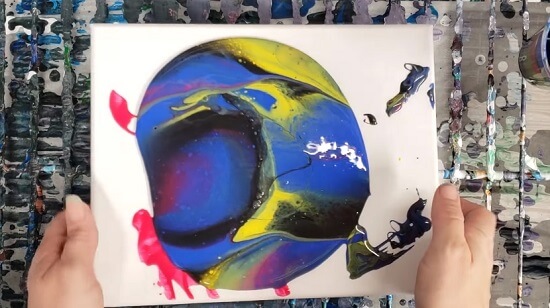Randy Charles is the owner of PaintCentric.com, a website dedicated to providing information, tips, tricks, and news about all things paint. With over 10 years...Read more
If you ever got yourself into painting and arts, you might have heard of the two most popular types of watercolors dominating the artistic world – acrylics, and tempera. Even though they are highly sought out paints by many professional painters, they are significantly different from each other in many aspects.
In the battle of acrylic vs tempera paint, the primary difference between both paints can be narrowed down to their respective ingredients’ involvement. Altogether, acrylic is a water-based, pigmented liquid paint that is emulsified with a synthetic polymer, while tempera is made of water-based, pigmented, egg-yolk-based paint.
And this article will show you the key differences between acrylic and tempera Paint: Get The Main Differences from their materials, consistency, price, and so on.
Acrylic Vs Tempera Paint: Side-By-Side Comparison Chart
In case you are in a hurry, here is a nifty table showing the main differences between these two paints. But, we suggest reading the entire article to have a broad idea of their differences.
| Factors | Tempera Paint | Acrylic Paint |
| Base | Water | Acrylic polymer |
| Price | Moderately-Low | High |
| Dry Time | 5 to 10 minutes | 30 minutes or less |
| VOC Levels | None to Little | Reasonable |
| Cleaning After | Easy (Water and Soap Only) | Difficult (Paint-thinner needed) |
| Range | Excellent | Average |
| Elasticity | Great | Great |
| Durability | Average | Great |
| Resistance to Marking | Great | Great |
| Mold Resistance | Average | High |
| Useable Surfaces | Paper, cardboard, cloth, wood, canvas | Metal, masonry, plastic, wood |
Acrylic Paint
This form of paint is described as fast-drying paint composed from pigments dispersed in an acrylic polymer emulsion. Paints made of acrylic are water-soluble, but they turn water-resistant once dry.

Based on how much paint is diluted with water or altered with media, gels, or even pastes. Final acrylic painting may resemble gouache, watercolor, or oil painting or exhibit unique characteristics that are not achievable in other media. You can also try to mix acrylic and oil paint if you dont want to dissolve water-based paints.
Acrylic paint is most typically used to paint canvases, but it can also be used to paint metal, wood, glass, plastic, and even glass.
Acrylic paint can be purchased at any art supply shop or on the internet.
[i2pc show_title=”false” title=”Pros & Cons” show_button=”false” pros_title=”Benefits” cons_title=”Drawbacks” ][i2pros]fast drying time
Available in a variety of vibrant colors
versatile array of implementations
The effects are permanent, making it ideal if youre looking for durability[/i2pros][i2cons]can contain toxic chemicals
relatively costly
If you make a mistake, you cant correct it as the paint is permanent
can get very messy[/i2cons][/i2pc]
Tempera Paint
This paint is a kind of composition of color pigments and a binder (like glue or egg yolk) as well as water. It’s created by mixing the pigments with the binder and then adding water to form the paste.

Tempera paint can be used in classroom projects as well as craft projects, props for theater posters, art projects, color mixing activities, painting windows, and much more.
It’s best suited for porous surfaces like poster board, paper, and cardboard.
[i2pc show_title=”false” title=”Pros & Cons” show_button=”false” pros_title=”Benefits” cons_title=”Drawbacks” ][i2pros]water-based
simple to clean
easy to paint over or take off
nontoxic
offers a fast-drying period
ideal for projects that require a paper
extensive range of coloring
free of allergens
less expensive than acrylic paint[/i2pros][i2cons]Dont last forever.
Not suitable for all surfaces
Layers of denser material may crack during drying
Remains water-soluble even in dry conditions
Disappears over time[/i2cons][/i2pc]
What Is The Differences Between Acrylic Paint And Tempera Paint
There are some obvious distinctions between tempera and acrylic paint since they perform differently due to compositional contrasts. Lets see how they differ from each other:

Pigment
The significant distinction between tempera and acrylic pigment is their ingredients.
Tempera is made up of egg yolks and eggs and pigments; in contrast, acrylic pigment is made of chemical compounds which are synthesized from polymers.
That results in tempera paints becoming purer in comparison to acrylic. Because tempera is made of natural ingredients and acrylic is made up of plasticizers, synthetics, thickeners, and solvents.
Lightfastness
Lightfastness is the resistance of a pigment, dye, or other colorants to fading due to light exposure. Water-based paints such as tempera and acrylic paint have variable lightfastness ratings.
Tempera is far less light-resistant than acrylic paint. Thus, most tempera colors and vibrancy will fade within a short span of time when exposed to sunlight. On the other hand, the acrylic paint’s pigment is lighter, which means it will maintain the original hue for a longer duration.
Permanence
Even though both tempera together with acrylic paints belong to a water-based category, they arent water-soluble. Tempera colors are water-soluble, meaning they are soluble even after being dried up, making them incredibly simple to wash off with water and soap.
In hindsight, for acrylic paints, the same cant be said as they arent soluble, which means after drying up, they will be there permanently, possibly for years, if left sealed.
Consistency
Tempera has a creamy consistency corresponding to other paints, while acrylic is either a thin or thick matte or glossy finish, transparent or opaque, based on the type of material mixed with it.
Dried Appearance
When dried, Acrylic is visually flat, whereas, Tempera is dazzlingly shiny due to the fact that it is composed of egg yolks.
Blending Ability
Both types of paint excel in terms of blending abilitiesboth tempera and acrylic mix colors beautifully.
Presence Of Toxins
Tempera and acrylic are two different types of paints with different media. Acrylics are manufactured from a variety of chemical solvents, whereas tempera is made from egg yolk pigment that is dissolved in water.
Acrylics are Environmentally friendly, but they do have some toxins in them. However, tempera does not have any toxins in it and is considered more environmentally friendly, but it takes longer to dry compared to acrylic.
Color
Tempera paint usually produces more vibrant colors than acrylics, thanks to the shininess coming from the egg yolk pigment.
Viscosity
Acrylics are denser than tempera paints, which makes them harder to use. However, if you’re just beginning to learn about painting, tempera paints could be the better option since it’s less difficult to control.
Price
Pricewise tempera is more affordable than acrylic paint as the variety of complex chemicals needed to make acrylic paint highly supersede that of tempera.
However, you can find cheaper acrylic paints in stores based on their brand value and pigment count.
Materials
Acrylic together with tempera paints can be used on a plethora of materials due to their versatile medium. This paint is ideal for use on the following materials: Paper, Ceramic, Wood, Metal, Fabric, Canvas, and Plastic.
On the other hand, Paper, Newspaper print, Finger painting, Poster boards, Paper-mache, Canvas, Masonite boards, Cardboard, and Sponge painting are just a few of the materials that Tempera paint works well with.
Can You Mix Tempera And Acrylic Paint Together?
The answer is simple: no. Since tempera is a paint that is made up of pigments derived from natural sources.
When these two types of paints are mixed together, the results can be unpredictable and often inconsistent. This is partly due to the fact that acrylics offer a natural dry glossy finish.

However, tempera’s texture is almost watercolor-like, which has faded over time. Because of that reason, painters favor acrylic for costly professional projects, whereas tempera is ideal for less expensive projects.
Can You Use Tempera Paint Like Acrylic?
It is possible to use tempera paint like acrylic, but it will not have the same qualities as acrylic. This paint has a straightforward formula that can be applied in many different ways.
Tempera paint, however, is a more complicated formula, and it should be applied with specific techniques. For example, if we use tempera on canvas which is ideal for oil and acrylic because of their thickness, the result will be the paint dripping all over the floor.
The reason is that tempera’s not thick enough to hold the mixture to a single point. This causes the components to break within.
How To Make Tempera Paint Into Acrylic?
Here is the step-by-step guide on how to convert an acrylic paint into a tempera in your own home.
Necessary Equipment
- A mixing container made of plastic.
- A base made of acrylic.
- Solution (water or alcohol similar to rubbing alcohol).
- Acrylic retarder.
- Wooden chopstick.
- Dry pigment.
- Painting spatula.
Step 1: Adequately grind the dry pigment with a painting spatula.
Step 2: Note and register the quantities of an acrylic base and pigment for a good consistency.
Step 3: Add the colorant into the base of acrylic of the container made of plastic and blend them thoroughly using a wooden chopstick till they are evenly distributed.
Step 4: Blend the solutions with an acrylic base that has been pigmented comprehensively.
Step 5: Mix in an acrylic retarder to illustrate how the acrylic paint dries.
Step 6: Install liquid paint and a regular glue mix container made from plastic and a wood chopstick in one place.
Step 7: Mix equal amounts of the paint in liquid form as well as the glue into the mixing container made of plastic.
Step 8: Combine the color and glue well using a wooden chopstick, and your acrylic paint will be ready in a few minutes.
Step 9: Stay sharp as, unlike your previous water-based tempera paint, this acrylic paint can stick to any surface for a prolonged time.
Step 10: Enjoy painting with your new dynamic acrylic paint.
Acrylic Or Tempera Paint: Which One Is the Right Choice For You?
Tempera is made of pigmented, egg-yolk-based paint and is the oldest type of paint. It dries quickly and covers a vast area with light, vibrant colors. On the other hand, acrylic pigments are made of plasticizers and solvents, which make it go on smoother but can be more challenging to clean up.

When choosing between tempera or acrylic painting, it’s essential to consider your personal preferences. For example, some people find that tempera colors are easier to work with because they are more fluid; others prefer the smoothness of acrylics. Ultimately, the best choice for you will depend on what you’re most comfortable working with.
Conclusion
To conclude, in the acrylic vs. tempera Paint comparison, we’ve learned a few things that put tempera paint and acrylic paint on opposite ends of the spectrum in terms of price and lightfastness, pigments materials, and so on.
Moreover, acrylic, as well as tempera paints, offer different benefits and drawbacks. For example, acrylic is a more durable paint but can be less flexible than tempera. However, tempera can be more flexible but is less stable.
Both paints can produce high-quality results, so it really comes down to personal preference and what you’re looking for in paint.

Randy Charles is the owner of PaintCentric.com, a website dedicated to providing information, tips, tricks, and news about all things paint. With over 10 years of experience in the painting industry, Randy has become an expert in the field and is passionate about helping others learn more about painting. He has written numerous articles on the subject and is committed to providing accurate and up-to-date information to his readers.
- Latest Posts by Randy Charles
-
Best Dunn Edwards Exterior Paint: Top Choices for 2023
- -
Best Bed Liner Paint for Whole Truck: Expert Choice
- -
Best Paint for Garage Door: Top 5 Options
- All Posts
